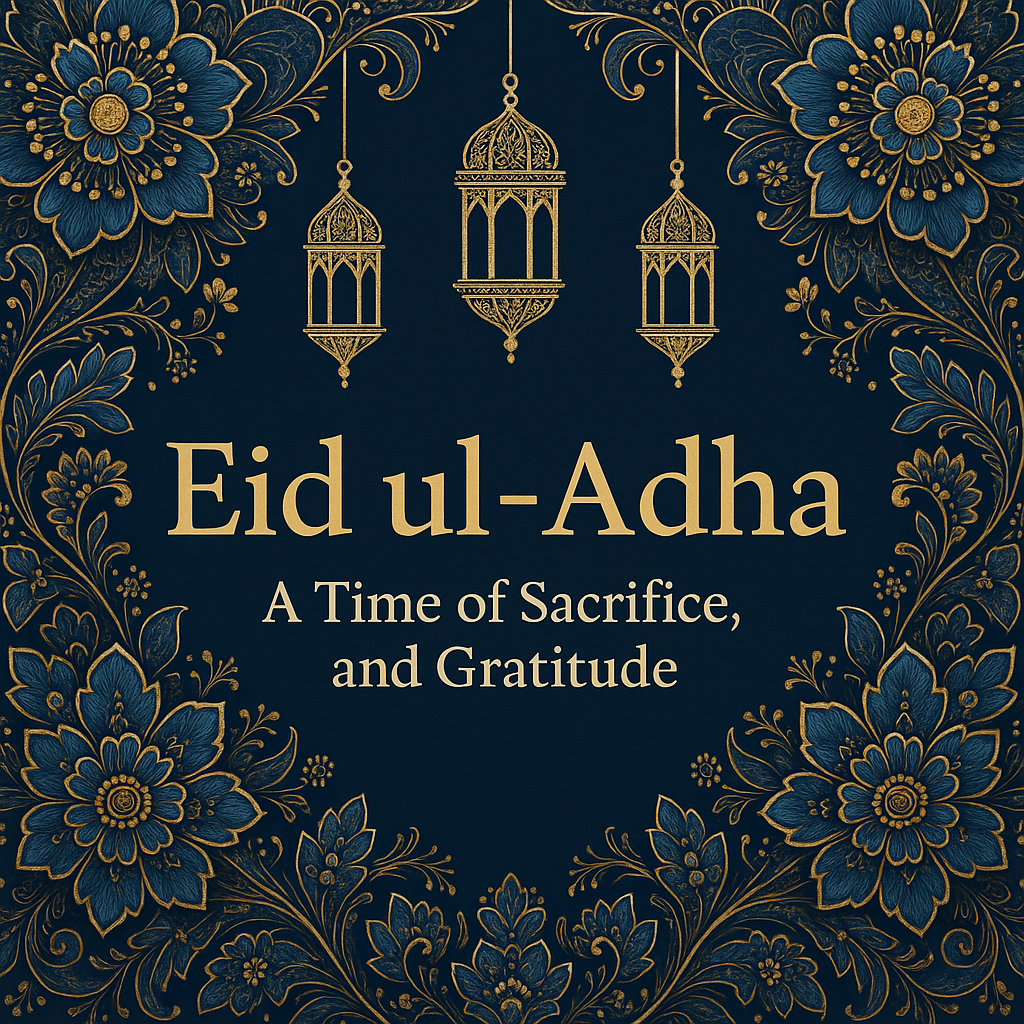



 Understanding Eid ul-Adha
Understanding Eid ul-Adha
Eid ul-Adha, also called the Festival of Sacrifice, is a very important holiday for Muslims all over the world. It takes place after the Hajj pilgrimage to Mecca and honors the story of Prophet Ibrahim (Abraham), who was willing to sacrifice his son in obedience to God. It follows Eid ul-Fitr, which marks the end of Ramadan, a month of fasting and prayer.
While Eid ul-Fitr focuses on breaking fast with joyful gatherings and meals, Eid ul-Adha centers around sacrifice, devotion to God, and caring for others. Muslims celebrate this time with gratitude, humility, and a strong sense of community.
During Eid ul-Adha, Muslims engage in religious and cultural practices that emphasize the importance of sacrifice and support for those in need. The story of Prophet Ibrahim reminds Muslims to remain faithful, kind, and generous. Coming together during this time reinforces the shared values of unity and compassion within the global Muslim community.
Why Eid ul-Adha is Important
Eid ul-Adha is deeply rooted in Islamic history and holds powerful lessons about faith and obedience. The holiday is based on the story of Prophet Ibrahim, who is honored in Islam, Christianity, and Judaism. Muslims believe that God asked Ibrahim in a dream to sacrifice his son Ismail (Ishmael) as a test of faith.
Ibrahim agreed to carry out God’s command, but just as he was about to sacrifice Ismail, God stopped him and provided a ram to sacrifice instead. To commemorate this act of obedience, Muslims around the world perform a symbolic animal sacrifice.
This story teaches Muslims to trust God fully and to live a life of obedience and faith. Eid ul-Adha also coincides with the end of Hajj, the annual pilgrimage to Mecca, which symbolizes unity and spiritual devotion. Those who are performing Hajj also take part in the sacrifice as part of their rituals.
What Muslims Do During Eid ul-Adha
There are several important religious practices that Muslims observe during Eid ul-Adha to demonstrate their faith and compassion:
The Sacrifice (Qurbani): Muslims who are able to do so offer a Qurbani by sacrificing a sheep, goat, cow, or camel. The meat is divided into three parts—one for the family, one for friends and neighbors, and one for people in need. This reflects the values of generosity and care for others.
Going to Hajj: Eid ul-Adha takes place at the end of Hajj, the spiritual journey to Mecca. Pilgrims participate in rituals that include sacrifice, reminding them of their dedication to God.
Praying Together: On the morning of Eid ul-Adha, Muslims gather in large groups for a special prayer called Salat al-Eid. This is followed by a sermon (khutbah) that encourages faith, sacrifice, and charity. Afterward, families and friends greet each other with 'Eid Mubarak' and share meals together.
Customs and Traditions
Muslims around the world celebrate Eid ul-Adha with unique customs that emphasize faith, family, and giving. While these traditions may vary by region, they reflect the core values of the holiday:
Praying Together: Muslims attend Salat al-Eid in large congregations, often held in open spaces or mosques. This shared experience brings unity and a renewed sense of devotion.
Sharing Meat: A key tradition is distributing the Qurbani meat to family, neighbors, and those in need. This ensures that even the poorest members of the community can enjoy a festive meal.
Giving to the Poor: Beyond meat sharing, Muslims are encouraged to donate clothing, money, and gifts to the less fortunate. This spirit of giving strengthens bonds and uplifts the community.
Special Meals and Visiting: Families prepare traditional dishes, gather to eat, and visit loved ones to celebrate. Foods like biryani, kebabs, and sweet treats are common.
Wearing New Clothes: Muslims often wear new or their best clothes as a sign of respect and joy for the occasion.
The spirit of Eid ul-Adha is expressed through compassion, gratitude, and joy. The act of sacrifice and charitable giving helps ensure that even those with little can experience the blessings of the holiday. Giving during Eid ul-Adha is a powerful reminder that no one should be forgotten.
What We Can Do to Help
Here are meaningful ways to support others during Eid ul-Adha:
· Donate Qurbani meat to families in need.
· Work with trusted charities to distribute food where it's most needed.
· Give meaningful Eid gifts like clothes, food, or toys to underprivileged children.
· Support organizations that run shelters, orphanages, or food drives.
· Invite family and friends to contribute to larger charitable programs.
Access to protein-rich meat can be life-changing for struggling families. A small act of giving can bring immense joy and dignity to those in need.
A Strong Community
The heart of Eid ul-Adha lies in how communities care for one another. When generosity and faith come together, they create a stronger, more connected society rooted in kindness and shared purpose.
